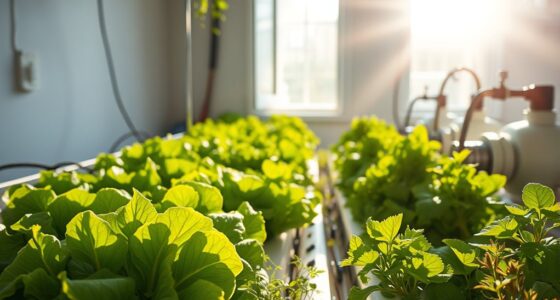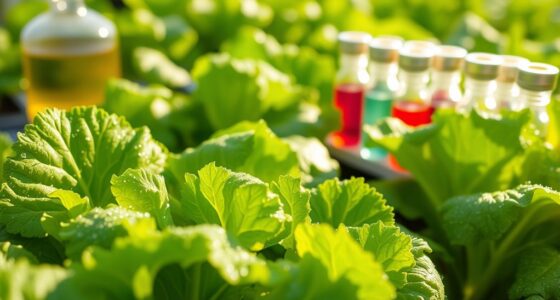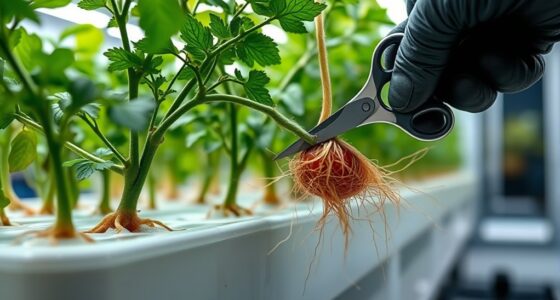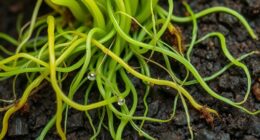To spot nutrient deficiencies in your hydroponic plants, look for symptoms like yellowing leaves, stunted growth, or poor flowering, which often indicate pH imbalance or nutrient lockout. Regularly test your water’s pH and nutrient levels to catch issues early. Adjust pH with pH up or down solutions and supplement nutrients as needed. By maintaining proper balance, you’ll keep your plants healthy—discover more tips to optimize your system below.
Key Takeaways
- Observe leaf color changes, such as yellowing or purple hues, to identify specific nutrient deficiencies.
- Monitor plant growth and development for stunted growth or poor flowering as signs of nutrient imbalances.
- Conduct regular water and soil tests to measure pH and nutrient levels, confirming deficiencies or excesses.
- Adjust pH to the optimal range (5.5–6.5) to improve nutrient availability and prevent lockout.
- Correct deficiencies by supplementing with targeted nutrients and maintaining stable pH and nutrient levels.

Have you ever wondered why your hydroponic plants show signs of poor growth or discoloration? The answer often lies in the nutrient balance within your system. Unlike traditional soil gardening, hydroponic setups rely entirely on nutrient-rich water, making it essential to monitor and maintain proper conditions. One of the first steps to diagnosing issues is soil testing, even though you’re working with water-based systems. Soil testing can help you identify imbalances in your nutrient solution, especially if you’re using a soilless medium or shifting from soil gardening. It provides insights into the pH level and nutrient concentrations, helping you determine if adjustments are needed.
pH adjustment is a vital factor in maintaining healthy hydroponic plants. Plants absorb nutrients most efficiently within a specific pH range, typically between 5.5 and 6.5. If the pH drifts outside this window, certain nutrients become less available, leading to deficiencies regardless of how much you add to the water. For example, a high pH can lock out iron, causing chlorosis, while a low pH might make manganese or zinc toxic. Regularly testing your water and nutrient solution allows you to catch these shifts early. Adjusting pH is straightforward: use pH up or pH down solutions, which are readily available at garden centers, to fine-tune your water until it hits the ideal range.
Monitoring your system closely helps prevent deficiencies by ensuring nutrients are accessible. When plants show signs like yellowing leaves, stunted growth, or poor flowering, these can be indicators of pH imbalance or nutrient lockout. By performing soil testing or water analysis, you get concrete data to guide your adjustments. It’s also important to keep a consistent feeding schedule and use quality, balanced nutrient solutions formulated specifically for hydroponics. Incorporating high-quality nutrients can further improve the overall health and vigor of your plants.
If deficiencies do appear, supplement with targeted micronutrients or adjust your feeding regimen accordingly. But always remember, fixing pH and nutrient levels first is key. Without the proper pH, your plants won’t absorb what they need, no matter how much fertilizer you add. Regular testing and pH adjustment keep your hydroponic system stable, ensuring your plants stay healthy and vigorous. This proactive approach minimizes deficiencies and encourages ideal growth, letting you enjoy a thriving hydroponic garden with minimal stress.
Frequently Asked Questions
How Can I Prevent Nutrient Deficiencies in My Hydroponic System?
To prevent nutrient deficiencies in your hydroponic system, regularly monitor and maintain the pH balance between 5.5 and 6.5, ensuring nutrients are accessible to your plants. Keep your roots healthy by providing proper oxygenation and preventing clogging. Consistently check nutrient levels and adjust your solution as needed. By maintaining suitable pH and healthy roots, you’ll promote strong growth and minimize deficiencies.
Are Certain Plant Species More Prone to Specific Deficiencies?
You might notice that certain species are more susceptible to specific deficiency patterns, and research suggests some plants, like tomatoes and peppers, are prone to calcium and magnesium deficiencies. While species susceptibility varies, it is crucial to monitor nutrient levels closely. Investigate if your plants show particular deficiency symptoms, and adjust your nutrient solutions accordingly to prevent issues. Understanding these patterns helps you maintain healthy, thriving hydroponic plants.
Can Nutrient Deficiencies Affect Plant Taste and Quality?
Yes, nutrient deficiencies can markedly affect plant taste and quality. You might notice flavor impacts, making your crops less flavorful or off-tasting. Additionally, a quality decline occurs as deficiencies hinder proper growth and development, resulting in less vibrant, less appealing produce. Addressing deficiencies promptly helps maintain ideal flavor and overall quality, ensuring your hydroponic plants thrive and produce the best-tasting, high-quality harvests possible.
What Are the Long-Term Effects of Untreated Deficiencies?
If you ignore nutrient deficiencies, your plants’ resilience drops, making them more vulnerable to pests and diseases. Over time, deficiencies weaken their overall health, stunting growth and reducing yield quality. This can lead to increased disease susceptibility, further harming your crop. Without intervention, these issues compound, causing long-term damage that’s hard to reverse, ultimately compromising your hydroponic system’s productivity and your success as a grower.
How Often Should I Test Nutrient Levels in Hydroponic Solutions?
You should test nutrient levels in your hydroponic solutions at least once a week. Studies show that consistent nutrient monitoring can improve plant growth and yield by up to 30%. Regular testing helps you catch imbalances early, preventing deficiencies. Adjust your testing frequency based on plant stage and system stability, but weekly checks are a solid rule to guarantee your plants get the right nutrients consistently.
Conclusion
Now that you can spot and fix nutrient deficiencies, your hydroponic plants will thrive like a well-tuned symphony. Remember, patience and observation are your best tools—think of yourself as the gardener of an ancient orchard, nurturing life with care and wisdom. With a little detective work and some old-school know-how, you’ll keep your greens healthy and vibrant, proving that even in this modern age, a gardener’s heart still beats strong.










